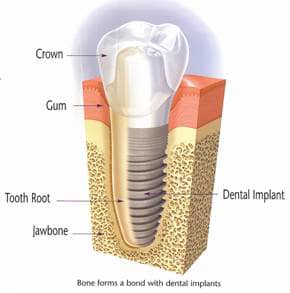Should a Dentist Cover the Cost of Grafting for a Dental Implant?
I went in for a consultation with my dentist to find out if I could get a dental implant and what the cost would be. I lost the tooth about ten years ago and the dentist said that I had lost some bone in the area, so I would need grafting on top of everything else. After reading information about the procedure, I’ve learned that the dentist could have treated the area where the tooth was extracted at the time of extraction and this would have helped prevent bone loss I’m dealing with today. I was not offered any type of bone loss prevention back when the tooth was extracted. Can I go back to that dentist and ask him to cover the expense of bone grafting now? If it had been offered, I probably would have done it and not having to pay the expense now will make it easier to afford dental implants now.
Thanks,
Ron
Dear Ron,

The procedure you’re referring to is usually referred to as “socket preservation” or “alveolar ridge preservation.”
Bone loss with Tooth Loss
Within 2-3 years of losing a tooth, most people will lose 40-60% of their bone in the area. They’ll keep losing bone at a rate of up to 0.5% every year thereafter. Simply put, the body “knows” the bone is no longer needed, and so it absorbs it. As you noted, that often makes it impossible to get a dental implant without more intensive bone grafting later and it also impacts the neighbor teeth as well as potential tooth replacements down the line.
Think of how devastating this is for patients who get complete removable dentures. Within ten years, they likely won’t have enough of a jawbone left to even retain their dentures. This is known as facial collapse.
Alveolar Ridge Preservation
The procedure for preserving the socket or ridge is actually a form of bone grafting. It involves placing bone material in the socket. Over time, the material helps develop stronger bone in the area and fills in the gap. Ergo, when you go to get a dental implant later, no grafting is necessary. Long-term research on the subject is minimal, but some studies suggest there’s a benefit to preservation procedures as much as 12 years after. However, it’s important to note here that a few successful cases doesn’t mean everyone will have benefit that long, nor does it mean that “successful” cases don’t require additional grafting at a later date either.
Socket Preservation is New
A decade ago, socket preservation techniques were still emerging. Most techniques were challenging and the cost of materials alone was $100 back then. Plus, there wasn’t a whole lot of research to justify the time and expense involved, particularly if a patient was on the fence about how they intended to replace the tooth. Technology and procedures have come a long way since then, but it’s still not something every dentist does.
Granted, we can’t go back in time to see if the dentist mentioned bone preservation to you, but consider your mindset at the time and why you lost that tooth. Would you have been interested in it knowing it would set you back $150 or more? Is it possible the dentist mentioned it and you brushed it off as unnecessary or costly at the time? If so, then it’s probably best to chalk this one up to a lesson learned. However, even if you’re totally certain he didn’t offer it, he didn’t necessarily do anything “wrong.” Again, this isn’t something all dentists do today, and it certainly wasn’t something they all did a decade ago. There’s no justification to go after him for the increased costs of your dental implant now.
Given the nature of your treatment, you can break this up into steps. There’ll be a period of time for healing after the grafting and another period of healing after the implant is placed. You can also work with a dentist who offers payment plans or finds other ways to make dental implants more affordable. Don’t skimp on quality, though. This is one area where the outcome is dictated by skill and time-tested materials.
This blog is sponsored by Naperville Dentist Dr. David Newkirk.